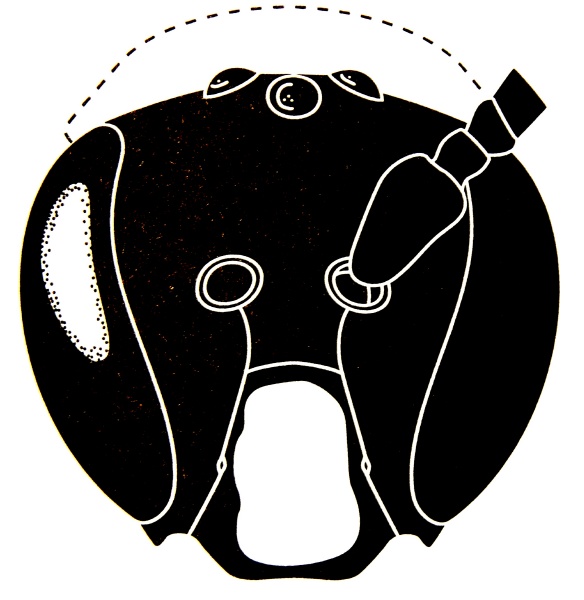Hylaeus in Hawaii

Hylaeus in Hawaii |

|
Hylaeus connectensIslands: Kauai, Oahu, Molokai, Lanai, Maui, HawaiiLocations: Kauai - (Kahuamaa Flat, Paaiki Valley, Polihale SP) Oahu - (Aiea Trail, Kaena, Lanipo Trail, Manana Trail, Manuwai, Pahole NAR, Palikea, Papali Ridge, Puu Kaua, Waianae, Waikane) Lanai - (Monro Trail) Maui - (Kahoma, Puu Kukui Rd., Waihee Ridge Trail) Hawaii - (Kipuka Nene, Oceanview Estates, Puu Waawaa) Habitats: Montane mesic to wet forest, dry shrubland, coast (Kauai) Plants: Acacia, Bidens, Broussaisia, Canavalia, Chamaesyce, Claoxylon, Hedyotis, Lipochaeta, Metrosideros, Myoporum, Psychotria, Rubus, Sapindus, Scaevola, Sida, Sophora, Styphelia Xerces: No info. Insects of Hawaii: Medium-sized bees with clear to smoky wings, unusual punctation of upper face with pits spaced about 1 pit width apart across face even at middle, supraclypeal area wider than long, basal area of propodeum lineately rugose in basal half and otherwise smooth to brow. Male with a single central facial mark, usually covering all or most of the clypeus and supraclypeal area, sometimes including adjacent paraocular areas or reduced to only the middle ofthe clypeus. Females black with pronotallobes marked or not, similar to H. coniceps, but scutum hair shorter. Fullaway (1918:394, 396-397) pointed out the possible synonymy of H. connectens with H. koae and H. vicinus, now known as H. insulae. The three names are considered here to apply to one species. All the names were published in the same 1899 publication by Perkins. The name H. connectens was chosen because it is based on the only male type and is not involved in homonymy. Each of the three names was originally described from few specimens and only one sex: H. connectens based on a male from West Maui, H. vicinus based on a female from Hawaii and a junior homonym, and H. koae based on a female from Oahu. We have seen bees of both sexes from Hawaii, Maui (both sexes from the type locality of H. connectens), Lanai (male only), Oahu (both sexes from the type locality of H. koae), and Kauai. Allowing for geographic variation in color and punctation, both sexes from all the islands are otherwise similar. Males are similar in body size, wide supraclypeal area, punctation of the upper face, scape dilation and arch, propodeal sculpture, and terminalia. The female types of H. koae and H. vicinus and topotypical females of H. connectens are similar in body size and structural characters. Based on small samples of mostly old specimens, bees from Oahu and Maui are more melanic and with smoky wings in comparison to those from Kauai and Hawaii with slightly smoky to clear wings. Males from Oahu and Maui have a wider supraclypeal area (W/L ratios 1.4-1.6, n = 11), only the clypeus marked with yellow (varying from a broad, full mark to a small spot), and dark, unmarked legs (other than the usual pale fore tibia and rarely a basal yellow dot on the other tibiae). Males from Hawaii have a narrower supraclypeal area (W/L ratios 1.2-1.3, n = 4) and more extensive yellow marking: clypeus and supraclypeal area yellow with or without an additional mark in the lower paraocular area, and legs may have basal spots of yellow on the tibiae and basitarsi. Both males and females from Kauai may have marks on the pronotal lobes, and females may have marks on the legs. Insects of Hawaii Volume 17 
UH/DOD: Hylaeus near military lands 
Other: |

|